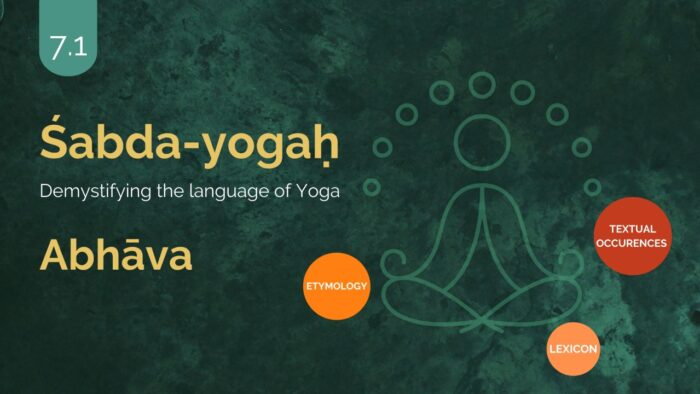Introduction
In this series, Yogic terminologies will be taken up and their -
- Etymological analysis,
- Lexical descriptions and
- Textual occurrences in Yogic literature and their commentaries, as available, will be presented. And finally observations will be made on the references.
Three texts - Yogasūtra, Haṭha-yoga-pradīpikā and Bhagavad-gītā are consulted for textual occurrences portion.
Śabda-yoga is intended to help students, teachers, and professionals of Yoga to develop a sound grammatical, contextual, and thereby an authentic and immersive understanding of Yoga terminologies.
List of Words
The words that appear in the Yogasūtras will be sequentially dealt initially and then terms from other prominent Yoga texts will be taken up. Every śabda-yoga unit will analyze five terms. Three compound terms are taken for analysis in this part viz - abhāvapratyayālambanā, anubhūtaviṣayāsampramoṣaḥ, abhyāsavairāgyābhyām. These three compound terms yield six unique words for analysis in this seventh unit. They are –
- abhāva
- pratyaya
- ālambana
- viṣaya
- abhyāsa
- vairāgya
Two terms anubhūta and asampramoṣa from the above three compounds are not taken up for detailed elaboration as their occurrence is limited only to one occurrence. These two are briefly explained while analyzing the compounds.
The Analysis of the compound terms
The three compound terms are
- abhāvapratyayālambanā,
- anubhūtaviṣayāsampramoṣaḥ,
- abhyāsavairāgyābhyām
1. अभावप्रत्ययालम्बना – abhāvapratyayālambanā
The Context
This compound term occurs in the Sūtra that defines the state of Nidrā. This term is part of the 10th Sūtra of the first Pāda of Yogasūtras.
The compound term is in the form of an adjective to the word Vṛtti in the Sūtra.
The compound Split
The Compound is split as follows –
न भावः, अभावः
na bhāvaḥ, abhāvaḥ (नञ्तत्पुरुषः)
Not presence (absence)
अभावस्य प्रत्ययः, अभावप्रत्ययः (षष्ठीतत्पुरुषः)
abhāvasya pratyayaḥ, abhāvapratyayaḥ (ṣaṣṭhītatpuruṣaḥ)
The cause of absence.
अभावप्रत्ययः आलम्बनं यस्याः सा, अभावप्रत्ययालम्बना ( बहुव्रीहिसमासः)
abhāvapratyayaḥ ālambanaṃ yasyāḥ sā, abhāvapratyayālambanā ( bahuvrīhisamāsaḥ)
That (activity of the mind) to which the cause of absence is the support.
As evident from the above compound split, Nidrā is described as an activity of the mind which takes support of the cause of the absence (of waking and dream states) to manifest. The cause of absence is described as the Tamas by commentators of Yogasūtras.
Important Constituent Terms
From this compound three unique Yogic terms can be seen –
- abhāva
- pratyaya
- ālambana
These are the first three terms that will be analysed as part of the seventh unit of śabda Yoga (7.1, 7.2 and 7.3).
2. अनुभूतविषयासम्प्रमोषः - anubhūtaviṣayāsampramoṣaḥ
The context
This is a compound term that describes Smṛti a Cittavṛtti. This term is found as part of the 11th Sūtra of the first chapter of Yogasūtra.
The compound Split
अनुभूतः विषयः, अनुभूतविषयः (कर्मधारयः)
anubhūtaḥ viṣayaḥ, anubhūtaviṣayaḥ
Object experienced (through the senses)
न सम्प्रमोषः, असम्प्रमोषः (नञ्तत्पुरुषः)
na sampramoṣaḥ, asampramoṣaḥ
Not losing
अनुभूतविषस्य असम्प्रमोषः, अनुभूतविषयासम्प्रमोषः (षष्ठीतत्पुरुषः)
anubhūtaviṣasya asampramoṣaḥ, anubhūtaviṣayāsampramoṣaḥ
Non-losing (non- forgetting) of the object experienced
As evident from the compound splitm, the act of remembering is described as non-forgetting the objects of past experiences.
Important Constituent term
From this compound the important Yogic term that emerges is Viṣaya. This is the fourth term (7.4) that will be discussed in detail as part of the seventh unit of śabda Yoga.
3.अभ्यासवैराग्याभ्याम्- abhyāsavairāgyābhyām
The Context
This compound term indicates the twin methods of abhyāsa and Vairāgya to attain the state of Citta-vṛtti-nirodha. This term is found as part of the Sūtra 12 in the first chapter of Yogasūtra.
The compound Split
अभ्यासः च वैराग्यं च अभ्यासवैराग्ये, ताभ्याम् (द्वन्द्वः)
abhyāsaḥ ca vairāgyaṃ ca abhyāsavairāgye, tābhyām, abhyāsa and vairagya, by the two.
The compound term is in the instrumental case dual number. It indicates that these two methods of abhyāsa and vairagya are instrumental in attainment of Citta-vṛtti-nirodha.
Important Constituent terms
Both the words -
- abhyāsa
- vairagya
are important Yogic terminologies that emerge from this compound term. This will be explained as part of the seventh unit of Śabda Yoga.
Etymological, Lexical and Textual Analysis of Terms
7.1. अभावः – Abhāva
| Words of Unit 7 | |
| 7.1 | Abhāva |
| 7.2 | Pratyaya |
| 7.3 | ālambana |
| 7.4 | viṣaya |
| 7.5 | abhyāsa |
| 7.6 | vairāgya |
Etymology
This is a compound term. The compound split has been shown earlier.
न भावः, अभावः (नञ्तत्पुरुषः)
na bhāvaḥ, abhāvaḥ
Not presence/absence
न Na is an indeclinable
भाव Bhava is derived when the suffix घञ् ghañ is added to the root भू – सत्तायाम्
bhū – sattāyām- to be. It is based on the grammatical rule (भवतेश्चेति वक्तव्यम् (काशिका), विभाषा ग्रहः bhavateśceti vaktavyam (kāśikā), vibhāṣā grahaḥ aṣṭādhyāyī 3.1.143). The suffix is used in the sense of kartṛ - the doer.
The derivative statement would be - भवतीति भावः. bhavatīti bhāvaḥ. – that which is/exists.
Lexicon - The term अभाव is not found in the Lexicon.
Textual Occurrences
Yogasūtra
The word Abhāva is found to be used four times in this text. The five occurences are elucidated briefly below -
अभावप्रययालम्बना वृत्तिर्निद्रा ॥ १.१० ॥
abhāvaprayayālambanā vṛttirnidrā ..
ततः प्रत्यक्त्चेतनाधिगमोऽप्यन्तरायाभावश्च ॥ १.२९ ॥
tataḥ pratyaktcetanādhigamo'pyantarāyābhāvaśca ..
तदभावात्संयोगाभावो हानं तद्दृशेः कैवल्यम् ॥ २.२५ ॥
tadabhāvātsaṃyogābhāvo hānaṃ taddṛśeḥ kaivalyam ..
हेतुफलाश्रयालम्बनैः संगृहीतत्वादेषामभावे तदभावः ॥ ४.११ ॥
hetuphalāśrayālambanaiḥ saṃgṛhītatvādeṣāmabhāve tadabhāvaḥ ..
Summary: Sūtra 1.10– This the first occurrence where as part of the definition of the Vṛtti – activity of the mind called sleep/nidrā we find the word Abhāva. Here Deep sleep is defined as that which has Tamas which is the cause of absence (of the waking and dream states) as its content. Sūtra1.29 ..- – The second reference in the context of explaining the outcomes of japa and meditation on the meaning of the Praṇava (oṅkāra). Realization of indwelling consciousness and abhāva- absence of obstacles in the path of Yoga are the outcomes. Sūtra 2.25 states that by the absence of avidyā - wrong understanding about the nature of oneself – the conjunction of the draṣṭā and dṛśya ceases and Kaivalyam where the Purusha is free from the conjuction of the drshyam (the material world and its cause) is attained. It is to be understood that Vivekakhyāti – clarity that the draṣṭā (consciousness) is separate from the dṛśya (the matter) – is said to eradicate the wrong understanding. The Vivekakhyāti in turn, is attained by the practice of Aṣṭāṅga yoga etc. Sūtra 4.11 .. – Here it has been clarified that the absence of (impact of) the Vāsanas can be attained. By achieving the absence of the factors of accumulation of Vāsanas – absence of Vāsanas can also be achieved. Hetu (cause- kleśa & karmas), phala (outcomes – Jāti, āyus & Bhoga), āśraya (the substratum – the mind) and ālambana (the support – the objects of the senses) are stated as the sources of accumulation of Vāsanas. (based on the commentary of Sadāśiva Brahmendra’s commentary)
Bhagavadgītā
There is just one reference to this term is found in this text.
नासतो विद्यते भावो नाभावो विद्यते सतः ।
उभयोरपि दृष्टोऽन्तस्त्वनयोस्तत्त्वदर्शिभिः ॥ २.१६ ॥
nāsato vidyate bhāvo nābhāvo vidyate sataḥ .
ubhayorapi dṛṣṭo'ntastvanayostattvadarśibhiḥ .. 2.16 ..
The lone reference from Bhagavadgītā clarifies that ātman – the self/consciousness is Sat- truly existing and hence it will never go into non-existence (abhāva).
Haṭhayogapradīpikā - There is no entry in this text
Tabulation of References
|
Abhāva
|
Yogasūtra
4 references |
Bhagavadgītā
1 reference |
Haṭhayogapradīpikā
- |
| Chapter 1 Sūtras 10, 29
Chapter 2 Sūtra 25 Chapter 4 Sūtra 11 |
Chapter 2 Verse 16 | - |
Observations
It is interesting to note the utilization of the word Abhāva is in various contexts involving the absolute and relative connotations.
In the absolute sense the Bhagavadgītā clarifies that there will no Abhāva/ absence of that which true/ really existent. Further in the removal of Avidyā and consequently attaining the absence of connection of the draṣṭā and dṛśya that leads to Kaivalya is also to be noted in this higher sense.
In the relative sense of the term we see that - in defining the state of deep sleep, overcoming obstacles of Yoga, rendering the Vāsanas ineffective the word Abhāva is used.
Thus it becomes useful to understand these various references to inform ourselves about the shades and contexts of utilization of the term - Abhāva.
References:
- Advaitaśāradā - https://advaitasharada.sringeri.net/
- Amarakoṣasampat - http://amara.aupasana.com/
- Aṣṭādhyāyī - https://ashtadhyayi.com/
- Aksharamukha - https://aksharamukha.appspot.com/
- Avyayakośaḥ, śrīśrīvatsāṅkācāryaḥ, saṃskṛtavidyāsamitiḥ, chennai, 2004
- Gītā Supersite - https://www.Gītāsupersite.iitk.ac.in/
- Nāmaliṅgānuśāsana alias amarakoṣa of amarasiṃha with the commentary vyākhyāsudhā or rāmāśramī by bhānuji dīkṣita, Edited with notes by M.M.Pandit Shivadatta Dadimatha, Chaukhamba Saṃskṛta Prathisthan, Delhi, Reprint 2002
- śabdārthakaustubha, cakravartī śrīnivāsagopālācārya, Vol 4, Bappco Publication, Bengaluru, Reprint 2009
- Yoga-vaiśāradī - https://kymyogavaisharadi.org/
Unit 7 To be Continued…





